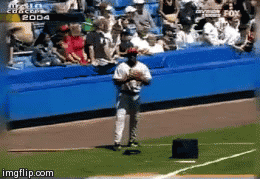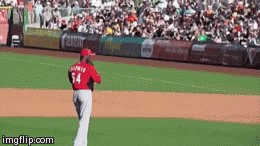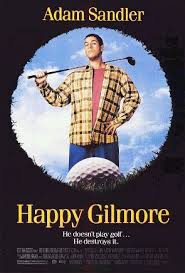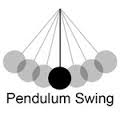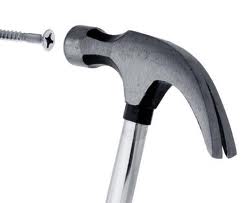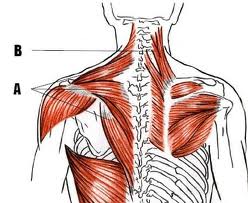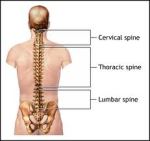Category: Shoulder/Rotator Cuff
Long Toss Part 1 – Does it Strengthen Your Arm ??
Since it has been a long time between writing articles I figured that I owed everyone who reads this site a great series of articles that tackles a hot topic in the baseball world;
LONG TOSS
- Does long toss strengthen your arm?
- Will it increase your risk of injury?
- Does throwing further mean you can throw harder?
These are some of the questions that I hope to shed some light on in this series of articles that is going to be at least 3 parts, maybe more by the time I’m done. Part one will talk about what long toss is and more importantly what it isn’t just so we are all on the same page. Part two will dive into the research that’s out there on long toss and break it down into Layman’s terms. In the final part I will try to piece everything together and give some of my thoughts about how and when to implement long toss.
So here we go, lets start with what long toss isn’t.
Long Toss is NOT Pitching
Long toss allows you get a running start and throw the ball up at a 45 degree angle. Check out Vlady and his pre-game long toss.
Pitching requires that you have to start from a stationary position and throw the ball at a slight down angle in order to hit the strike zone.
Obviously they are different from one another.
The ability to throw the ball far is great because that most likely means that you have the ABILITY to throw hard but that’s only one part of the game. In order to succeed at any level you need the SKILL to change speeds and pitches while hitting your spots.
Let’s look at golf for example. Who would you pick to win a round of golf Rory Mcllory or Tim Burke? For those of you who don’t know Tim Burke, he is the 2013 long drive world champion and he can drive the ball 427 yards!!!
Rory only averages 310 yards which isn’t bad (3rd on tour) but it’s over a 100 yards shy of Mr. Burke. The problem for Tim Burke is that they are competing in golf and not a long drive competition which is why I would pick Mcllory to win in a head to head battle. Golf requires a lot more than just a long drive. Being long off the tee certainly helps but as the saying goes “you drive for show and put for dough”. With pitching our putting is hitting spots while mixing speeds and pitches. After all just look at what happened to Happy Gilmore in one of the best movies of all time. Once he worked on his short game he was able to defeat the evil Shooter McGavin and win back his grandmother’s house.
Both you and your pitching coach need to figure out where your strength’s and weakness’ as a pitcher are in order to figure what you should be doing more of in order to succeed on the mound. Just because you can throw far doesn’t mean you know how to pitch.
Why Are You Long Tossing?
If you ask this question to any player you’re probably going to get this answer:
I am trying to strengthen my arm!!!
Anytime we talk about strength we should be talking to the experts: strength coaches. In an ideal world long toss is where there should be some overlap between the pitching coach and the strength coach. I’ve been fortunate enough to be both which gives me a unique perspective on the subject.
Since we have heard many pitching coaches give us their thoughts on long toss I thought I would take more of a strength coach approach to the subject.
Long Toss is Just a Tool
If someone wants me to help improve their throwing velocity I do a full assessment and then I use my training tools according to the athletes needs in order to achieve this goal. There are plenty of tools out there to help improve throwing velocity like weight training, stretching, weighted balls, long toss and plyometrics to name a few. The secret of good coaching and improving throwing velocity is to know what tool you should be using because there is no one size fits all approach. You also need to know how to properly use each tool otherwise you might get hurt.
Thanks to the work of Alan Jaeger long toss has become an extremely popular tool in recent years and when anything becomes popular enough there are going to be people that try to tear it down and we end up with a pendulum effect.
This is a term I learnt from the strength & conditioning world because there always seems to a new training tool or philosophy that burst onto the scene and becomes very popular. Think of things like high intensity interval training (HIIT), Swiss Balls, Kettlebells or any other fitness related product that you might have seen on an infomercial . Some tools become so popular that trainers will only use this one particular tool for their entire workout. Following a certain period of popularity there is usually a back lash that may or may not be driven by some type of research that denounces this particular tool and its supposed benefits. Trainers and athletes then stop using this tool all together.
After a while the pendulum stops swinging back and forth and the tool in question finds its resting place. Smart strength coaches however recognize that every tool has its purpose and it become part of their arsenal and will use this tool when the situation calls for it. Good coaches have big tools boxes and know exactly when and how to use each tool.
As far as tools go long toss is pretty powerful and can provide benefits all by itself but when it is used in conjunction with others tools like weight training and mobility training the results can be even better. We have to realize that there are a lot of tools out there at our disposal and it is our job as coaches to select the right one.
If all you know is long toss it’s like being a handy man that only knows how to use a hammer and if you only know how to use a hammer everything starts to look like a nail. This means that players are sometimes forced into long tossing when another tool might be a better fit for the job.
Not the Right Tool for the Job!!!
Long Toss is a Form of Exercise
As a strength coach I have a lot of tools in the form of exercises to get the job done. Exercises can be classified into one of three categories depending on their intended effect on the neuromuscular system according to Dan Baker (a very smart Australian Strength Coach).
- General Exercises
- Special Exercises
- Specific Exercises
So what kind of exercise is long toss? To answer that lets look at these three categories in greater detail.
1. General exercises are those that we most commonly associated with the weight room and their goal is to increase the maximal force producing capabilities of the muscles that we need to throw. We need strong legs to throw hard so exercises like lunges and squats can be classified as “general”. This category has the biggest selection of exercises to choose from and because of that we must look at the risk vs. reward aspect of every exercise we select in order to maximize our training time in the weight room.
“Generally” Speaking this is a great exercise!!!
2. Special exercises are more closely related to the actual athletic act and can be thought of as exercises that convert strength into power. For throwing its exercises that might include jumping or med ball throws. While there are a lot of exercises in this category we have to select those that have a chance of producing some type of carry over from the weight room to the mound – this was basically the subject of my master’s thesis.
Just like with general exercises we have to weigh the risk vs reward aspects of each exercise. Olympic weight lifting is an exercise that would fall under this “special” category. As a player or coach you have to ask yourself if the risk of hurting your wrists and elbows along with the time needed to learn the Olympic lifts PROPERLY out weight the potential increase in force production that you would gain.
3. Specific exercises are similar in specific motor pattern, muscle recruitment, temporal sequencing and firing frequency to the actual act of throwing a baseball. Long toss would fall under this category as would weighted ball throwing. The amount of exercises that fall under the “specific” category are limited and as result they tend to get used a lot.
Great throwing programs use tools from all three categories and they are designed to work off of each other. The strength you build with the general exercises is converted into power with the special exercises and then that power needs to be displayed in a specific manner to the pitching act which is where specific exercises come in.
Now that we know that long toss is just a tool/exercise that we can use to improve our throwing velocity we need to learn:
- Who needs it?
- When to use it?
- How to use it?
- How often to use it?
I hope to answer these questions in part three but before we do that we have to look at the actual research that has been done in the area of long toss in order to gather as much information as we can before trying to answer these types of questions.
Sincerely,
Graeme Lehman, MSc, CSCS
Pitching 8 months a Year Might not be a Great Idea – Studies you should know about
The study in question today comes from the Dr. Andrews lab in the American Sports Medicine Institute in Birmingham, Alabama.
Risk Factors for Shoulder and Elbow Injuries in
Adolescent Baseball Pitchers
By: Samuel J. Olsen II, MD, Glenn S. Fleisig,* PhD, Shouchen Dun, MS, Jeremy Loftice, and James R. Andrews, MD
What did they want to find out?
If the pitching practices of adolescent (14-20yrs) pitchers that DON’T have any history of arm injury are different then adolescent pitchers that DO have a history of arm problems.
The goal here is to identify common factors that most pitchers with injuries have in common and compare to no injured throwers in order to find out which ones may contribute to arm problems which nobody wants.
How did they find out?
They had pitchers both injured and uninjured (90 and 45 respectivly) fill out a detailed questionnaire that asked them questions like:
- How tall and heavy are you?
- How many innings do you pitch?
- How many months out of the year do you pitch?
- Your coach cares most about? the game, the season or your career?
- Do you exercise for baseball?
- Do you ice and/or stretch after you throw?
- If you come out of the game as a pitcher do you stay in and go to another position?
- Out of 10 pitches how many are fastballs, breaking balls, change ups?
- Do you use anti-inflammatory drugs?
- How old were you when you started to shave?
And many, many more questions like this.
What they found out?
The significant differences between the groups were that the injured group pitched more months per year, games each year, innings per game, pitches per game, pitches per year and warm up pitches before game. The injured group was also 4cm taller and 5kg heavier on average – there was no age differences between the groups. The injured group averaged 88mph while the uninjured group threw 83mph.
Let’s look at some of these factors more closely.
1. Height and Weight
While the two groups were very similar in terms of age the injured group was on average 4cm taller and 5kg heavier. At younger ages most pitchers lack the strength needed to handle the forces that come with throwing a baseball as hard as you can so it is no surprise that heavier and taller pitchers have more injuries because they need even more strength.
If you’re tall for your age great!! This height will come in handy when you get older and stronger so make sure that your arm is in good shape to take advantage of your long limbs in the years to come. For coaches and parents out there make sure the taller and heavier pitchers don’t over do it.
As far as weight goes it can be a good thing because it can add to the total amount of force that you generate and deliver to the ball, CC Sabathia maybe?
With added weight comes the need for added strength otherwise the extra mass will work against you. Any weight that you want to add should come in the form of muscle and not junk food.
2. How much, how often and how hard should you throw?
It really comes as no surprise that pitchers who threw more often get hurt but we need to throw in order to get better. We need to find out how much pitching there needs to be.
One factor that jumped out was the members of the injured group that needed surgery (I would classify this injured) pitched competitively for about eight months a year while the non-injured group averaged only five and half months.
Maybe playing on three different teams might not be the greatest idea.
It should be noted that the injured group reported average velocities of 88mph compared to 83mph in the uninjured group. While these numbers may not be completely accurate because I am sure that any adolescent pitcher is going to inflate their velocity numbers but at least both group most likely exaggerated their numbers equally. It’s just like basketball players and their vertical jumps, football player’s and their forty times or men in general with their bench press totals. Take them with a grain of salt until you see them.
Now hard throwers obviously have to deal with the higher forces needed to reach these higher velocities which can place them a higher risk of injury. Think of Joel Zumaya’s arm problems compared to the fact that Jamie Moyer is still throwing in his 40’s.
But hard throwers are more likely to pitch more often since every teams likes to put their hardest throwers up on the bump. Hard throwers are also more likely to go participate in “Showcases” in order to be recruited for higher levels of baseball. While great for exposure these “Showcases” may be doing more harm then good by getting pitchers to max out their arms trying to impress scouts and coaches by throwing as hard as possible in hopes to impress.
These “Showcases” can be especially damaging when they are held during what is typically the off-season. This not only adds more competitive pitching months to the yearly total but has the pitcher going from a state of no throwing to going all out in order to get that scholarship. Trying to go from zero to hero like this is bad news.
If you’re good enough and play organized baseball in the summer scouts will find you so don’t worry about firing up the old pitching arm in winter to go pay someone to go show them what you got.
3. Use of Anti-Inflammatory Drugs
Again this one is not a shocker. If you need to pop a couple of Aleve’s before you pitch to numb the pain that you know is coming you might what to get your arm checked out.
Hopefully you can put this information to good use and help prevent arm injuries from occurring in the first place.
Graeme Lehman, MSc, CSCS
The Best Shoulder Exercises – video’s
This final part of the Shoulder Series will look at videos which demonstrate the best exercises and drills that you can do in order to improve performance and decrease the chances of injury.
I have broken shoulder care down into four main categories
- Rotator Cuff Strength
- Reflexive Rotator Cuff Conditioning
- Scapular Stability
- Thoracic Spine Mobility
Rotator Cuff Strength
The importance here is that we ensure that each of the individual rotator cuff muscles is strong enough independently so that they can help contribute to shoulder health. Every baseball player already does a version of the following so it shouldn’t be hard to make the adjustment to doing the best ones. And please take your time and do them properly – the times that I have seen these exercises being performed poorly highly out numbers the times that I have seen them done properly.
Side Lying External Rotation
The goal here is to simply strengthen the infraspinatus and teres minor. Try to perform this with a weight rather than a band when possible.
Full Can Exercise
Everytime you perform an exercise you must look at the risks versus the rewards. The full can offers all of the rewards with none of the risks that accompany the empty can drill so the choice is simple. The goal is to strengthen the supraspinatus.
No-Money
This is a great exercise that you will see in the scapular stability section as well. It strengthens the infraspinatus and teres minor while working on scapular stability – namely lower trap activation.
You can obviously do this one standing up and I recommend that you stand touching the corner of a wall to help you get the feeling of squeezing your shoulder blades together.
Internal Rotation at Zero Degrees
High subscauplaris recruitment but be sure not to turn on the powerful pecs and lats by using perfect form as always.
Reflexive Rotator Cuff Conditioning
I am a Strength & Conditioning coach and I consider the conditioning part of my job to help prepare the athlete for the demands of their sport. In the case of an overhead athlete it is important to condition the rotator cuff for the act of throwing. Its role during this activity is to dynamically stabilize the head of the humerus within the glenoid fossa – keep the ball inside the socket.
Here are a couple of videos that demonstrate some drills that force the rotator cuff group to perform its role to dynamically stabilize.
Screw Drivers
This one is being performed with a kettlebell bottoms up which I love – this unstable load forces the muscles of your rotator cuff to fire in order to keep the load from falling. You can substitute a med ball balancing on your palm.
Perturbations
These kinds of exercises are great but require a training partner. The training partner provides resistance in multiple directions in an unpredictable manner so that you are forced to reflexively stabilize which again is the goal here. Ensure that this does not become a game with a winner and loser – the push should be subtle, no slapping noises, and hold the force for a couple of seconds.
Scapular Stability
The scapulothoracic joint should be stable and provide our GH joint with a solid base from which it can generate and transfer extreme levels of power and velocity. The majority of this stability falls onto the hands of the musculature which must work to keep the scapula in its most optimal position on the thorax. We are going to target the serratus anterior and lower traps in particular.
Here are some of my favorite exercises to accomplish this goal.
No Money
This exercise makes the list again in another category which means that it must a really good exercise since you’re killing two birds with one stone – scapular stability and rotator cuff strengthening.
See previous No Money Video above
Hand Walk Outs
Anytime you walk on your hands you force the muscles that stabilize your scapula to contract plus you will recruit the “core” to stabilize your trunk which is obviously important to throwing a baseball as hard as you can.
Face Pulls
In this video Strength and Conditioning guru Charles Poliquin discuss a great exercise that he uses to balance out the strength of his athletes. Most people are too weak in the upper back and the face pull is a great exercise to gain this needed strength.
Standing Cable Row
This is another great exercise to increase rowing strength and the one arm standing version enhances the scapula stability demands of this already great exercise.
Wall Slides
One of my favorites and in my opinion everyone can stand to benefit from. Make sure that you do this one throughout the day and please do it the right way. Great tip from my friend Dr. Jeff Cubos is to focus on proper breathing when you reach the end of your range of motion.
Y’s and T’s
This is a great exercise that can be done before any throwing or lifting session. If you want to do it at the yard please ensure that you perform it with a nice flat back.
Pushup plus
To get a bit more benefit from this exercise try putting your feet up on a bench – this has been shown to increase the recruitment of the serratus anterior.
Thoracic Mobility
The thoracic mobility is an untapped source of potential velocity that many players miss out on because they sit in a hunched over position the majority of the day. So sit up straight or even better get up and move around a little bit – the best posture is the one that is always changing. The lack of thoracic mobility can also put you at a higher risk of sustaining an injury to your shoulder.
Thoracic Extension
We sit in thoracic flexion all day so it only makes sense to get into extension. This low cost piece of equipment – two tennis balls and hockey tape – will pay off big time.
Wall Slides
This exercise is another that falls under multiple catagories so be sure to add it into your daily routine as often as you can.
Thoracic Extension & Rotation
The next piece of the puzzle is to add rotation since you will require this to launch that 5oz baseball over 90+mph. Below are some of my favorites.
Club/Bat Swinging
Club swinging is making a resurgence back into the strength and conditioning world – I say resurgence because this type of exercise has been around for centuries but some of the smartest people in the exercise community are rediscovering this great form of exercise which really helps improve shoulder function by promoting optimal thoracic mobility.
I don’t own clubs but I have been playing around with small baseball bats and they work really well. I will be posting more club swinging in the future. I am really excited to learn about club swinging since I see some huge potential.
This video demonstrates some movements that you can try with small bats or by choking up on normal sized bat. Do not try to go heavy with this by adding a weighted doughnut onto the bat – more is not better. Become fluid with these movements and even start by doing one side at a time to make sure you can do both sides properly. You might want to wear a helmet the first couple of times you try as well.
Bottom Line
Try playing around with all of these exercises whenever you can – there is a lot of down time before and after practices. You can find some time to squeeze in some of these exercises on a regular basis. Don’t overlook the importance of breathing as well which was mentioned in the previous post.
I hope that you have enjoyed the “Shoulder Series”. There will be more info on the shoulder to come but for now this is a great start.
Graeme Lehman.
Arm Pre-Hab – more than just Rotator Cuff exercises
Putting it all together – the Hollistic Approach
I really need to get going with some research that is in my area of thesis but I know how important arm care is which is why I wanted to throw this series together, pardon the pun. I will be doing more in the future however I will give you a great list of resources where I have got the majority of my information from:
- Eric Cressey – web site and Optimal Shoulder Performance Videos
- Mike Reinold – web site and Optimal Shoulder Performance Videos
- Shirley Sharmann – Diagnosis and Treatment of Movement Impairment Syndromes
- Jeff Cubos – web site
- Gray Cook & Brett Jones – Secrets of the Shoulder DVD
- Dr. Nikita Vizniak – Muscle Manual
What I have learnt from these incredible resources is shoulder care goes beyond the strength of the individual rotator cuff muscles – we have to look at the entire body. While it is beyond the scope of this article to look at the entire body I will dig into 4 different areas that need to be addressed to ensure overall shoulder health.
- Reflexive Rotator Cuff Training – As a group the rotator cuffs job is the reflexively stabilize the humeral head so we need to train it do this.
- Scapular Stability – The scapula must be in the right position of the rotator cuff muscles to function properly – if the scapula is misaligned then the individual strength of these muscles matters not.
- Mobility in the Thoracic Spine – imperative for optimal performance as well as avoiding injuries.
- Breathing Patterns – we do this exercise all day everyday but if we don’t do it the right we might lock up some muscles that will restrict our mobility and steal power that we could have produced.
This holistic approach respects the fact that our bodies are essential long chain and a weak link can cause a host of problems almost anywhere along this chain. If you have an injury due to throwing and focus your attention solely at the site of pain you might miss the boat in trying to figure out what caused the problem in the first place. This is why top therapists will take a look at how the body is functioning near the site of the pain to look for some usual suspects which are at the root of the problem.
Let’s use an analogy here to explain what I am talking about.
Jonny and Billy are paired up to do a project and are both assigned 50% of the work. Billy is a slacker and doesn’t do his fair share which forced Jonny to do the majority of the work all by himself. Who do you think would complain about this situation? Jonny!!! But who do you think is causing the problem? Billy!!!
If your shoulder hurts you will probably have to do some work to repair whatever damage has been done but if you want to avoid this problem from reoccurring you are going to have to find the root of the problem.
Reflexive Conditioning
This series went into great detail of what each rotator cuff muscle does individually when we concentrate on isolation which is important to ensure each muscle has the necessary strength to do its job. However as a baseball player you need the rotator cuff to dynamically stabilize the head of the humerus so that it stays in the “sweet spot” within the glenoid fossa because if it doesn’t then bad things can happen.
Throwing a baseball as fast as you can to a very specific spot with someone swinging a bat is hard enough as it is so imagine how tough it would be if you had to tell your supraspinatus to pulldown on the humerus just enough to centre the humerus within the glenoid fossa. Luckily your rotator cuff is designed to provide this stability without you having to think about which is why I refer to it as reflexive conditioning/stabilization.
Scapular Stability
Because the GH joint (a.k.a shoulder joint) is so mobile we need for the joints on either side to be stable (joint by joint approach – Boyle et al 2008 – not a real reference but it deserves mention). The joints that anchor the GH joint are the elbow and scapulothoracic joints.
It is easy to see why the elbow joint is made for stability with the bone on bone connections but the scapulothoracic joint pretty much just floats on top of the ribs with only one little bone on bone connection at the acromion-clavicular (AC) joint to provide some stability.
The rest of the stability demands fall on the muscles that connect it to other bones in the body and must keep hanging in exactly the right place. There are 18 different muscles that have some type of connection with the scapula; some have a tendency to become tight pulling the scapula out of position causing others to become weak and allow for a misplaced scapula.
These are some common muscles that need to be massaged and stretched:
- Pec Minor
- Teres Major
- Latissimus Dorsi (only some of the fibers attach but it’s a good to stretch anyways)
- Superior Traps
- Levator Scapula
These are some of the common muscles that need to be strengthened
- Serratus Anterior
- Lower Traps
Lower Traps
When you where about the traps you think of big body builder with no neck from doing lots of shrugs. This big muscle does cause you to shrug your shoulders but only the upper part – the traps can be divided into an upper, middle and lower portion because the fibers run at different angles and do different actions. Just like the deltoids which are divided into an anterior, middle and posterior groups which each produce different actions.
- Upper portion – upward rotation and elevation (shrugging motion)
- Middle portion – retraction – pinching your shoulder blades together
- Lower portion – upward rotation and downward depression.
The lower traps are going to be the part of the traps that we are going to focus on the most because they are the most neglected and will help us keep our shoulders strong and healthy if they are working properly. The reason for this is that they help tilt our scapula posteriorly as well as external rotation during arm elevation which decreases the chances of a sub-acromial impingement injury.
Serratus Anterior:
This muscle holds our scapula against our rib cage. If this muscle is weak it allows the scapula to “wing off” from the rib cage. Its action along with the pec minor is to protract the scaulea – this means to pull your shoulder blades apart. Hold your arms out in front of your with your elbows locked standing nice and tall – should look like Frankenstein. Now try to reach just a little further by allowing your shoulder blades to be pulled apart – that is the action of your serratus anterior.
The most common exercise for the serratus anterior is what’s called a pushup plus where you do what I described previously only that you do it from a pushup position. In order to make it better try elevating your feet and placing your hands in a diamond position underneath your forehead. (Lear et al. 1993).
T-Spine Mobility
As a society we have the tendency to sit down way to often and for too long which results in hunch backs rob of us mobility we could have used to generate more velocity. When we sit down most of us go into a flexed position within our T-Spine and when we throw we want to have the ability extend and rotate.
My next post will give you a couple of drills to do that will help restore some of this lost mobility but you need to avoid being in a flexed position as best you can no matter if you are sitting or standing. Thirty to Sixty minutes a week of mobility drills do not stand a chance against countless hours of poor posture.
Breathing Patterns
Often times you hear a coach telling their athletes to relax and breath – this is great because it will help free up this locked t-spine area. Breathing is really important and often overlooked if you think about it half of each day you are in a state of inhalation while the other half is spent in exaltation. If you do something all day everyday you need to master this movement to ensure you are doing it the right way.
Again it is well beyond the scope of this article but try this drill:
Lie on your back with your knees bent at 90 degrees so your feet are flat on the ground – place one hand on your stomach and the other on your chest. Take deep breaths pulling in lots on air then exhale about 90 percent of the air in your system – this is essentially exaggerated breathing but you should only feel the hand on your stomach moving while the one placed on your chest needs to be still. This means that you are using your diaphragm to breathe which is what is it specifically designed to do. “Chest” breathing puts undue stress on muscles like your pec minor which as a result can become tight and overactive restricting your mobility.
Practice this one as much as you can and since you need to breathe all day everyday don’t tell me you don’t have the time.
Here is a video that goes into more detail:
http://www.youtube.com/watch?v=CK1ZJbFbeyk
Bottom Line
The “new” arm care program/pre-hab must go beyond your basic rotator cuff muscles to ensure that the whole system is working.
I will try my hand doing a couple of videos to show you my favorite drills and exercises for all of these different areas that I discussed.
But in the mean time….
SIT UP STRAIGHT!!!
Subscapularis
Subscapularis
This is the last of the rotator cuff muscles and it’s the largest and strongest.
Where is it?
This one is tough to get your hand on because of the fact that it is underneath the scapula
(hence the name) and you can’t really get at it from the front because of the rib cage.
If however you put your right hand behind your back then take your left hand around your back and try to dig your fingers underneath the medial border of the scapula you can get at the origin of this muscle. In this position you can palpate them through the trapezius and rhomboids that lie over top.
What Does It Do?
It is the largest muscle of the rotator cuff allowing it to create 1725 N of internal rotation force at 90 degrees and 1297 at 0 degrees of abduction (Decker et al. 2003). However at zero degrees of abduction the pectoralis major, latissmus dorsi and teres major all assist in creating internal rotation while the 90 degree version didn’t recruit these bigger muscles allowing you to isolate the subscapularis.
During the throwing motion the subscapularis help depress the humeral head to prevent injury but it also contributes to the act of throwing by providing some internal rotation power for when your arm starts to rotate to deliver the ball.
What Are the Best Exercises?
The most popular exercises you will see are standing internal rotation exercises with the
arm either tucked at the side or at 90 degrees in the field goal position.
As mentioned above the 90 degree version has the benefit of not have bigger muscles like the pecs and lats take over allowing you to target the subscapularis specifically but it this position isn’t as stable compared to when your arm is tucked in at your side.
There are some other exercises that aren’t your typical “rotator cuff” exercises that have
been shown to promote some high activation from the subscapularis. The pushup plus which is most regarded as a serratus anterior exercise recruits the subscap and so does the band bear hug which is essentially the same motion as the pushup plus but with a band. (Decker et al. 2003)
There are some “new” exercises that have you training the subscapularis in a diagonal motion with your shoulder abducted which offers up the ability to train in a “functional pattern.”
Bottom Line
All of these exercises are great plus it nice to mix things up so you aren’t the same exercise every day.
Of the rotator cuff muscles it is the least likely to be weak due to its size and the fact that it gets used every time you throw – ensure that you hit the other rotator cuff muscles prior to attacking the subscapularis.
Be sure to check out the next article which will look at other areas of the body and shoulder that need to be addressed in order to promote shoulder healthy and performance.
Graeme Lehman
